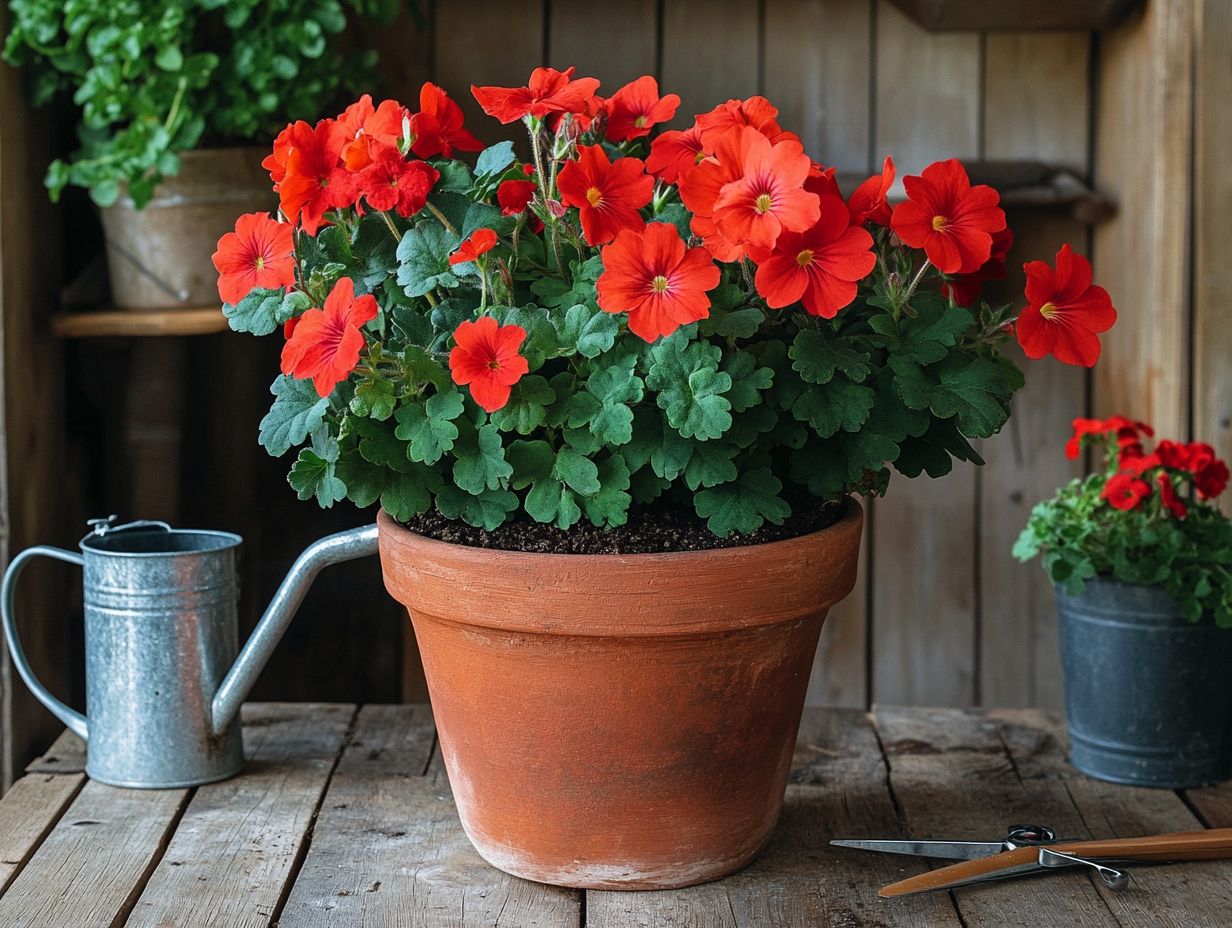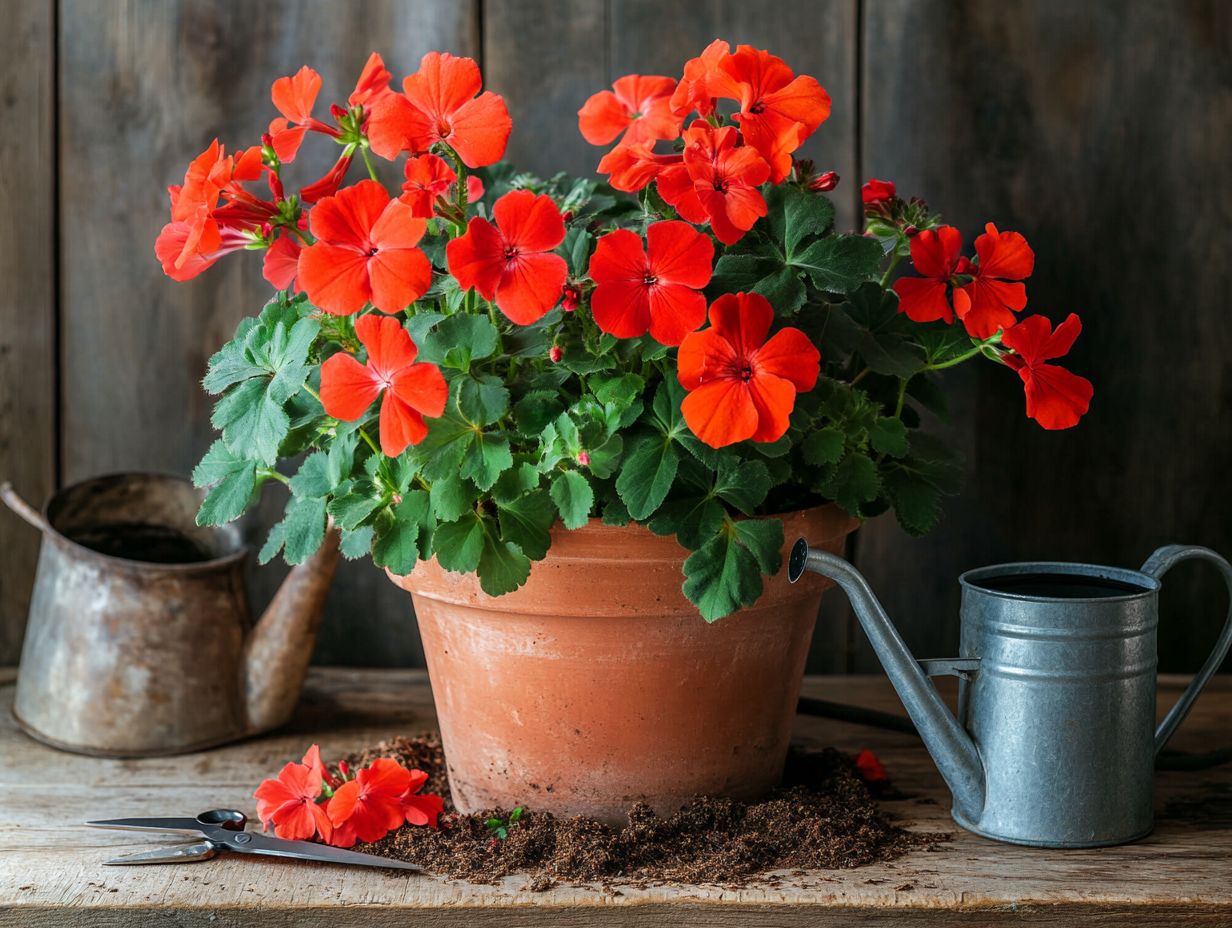What Are Eco-Conscious Activities to Try?
Geraniums are not just a feast for the eyes; they re also remarkably easy to propagate, which is why they re beloved by gardeners everywhere.
Explore the different methods for propagating these vibrant plants, from seeds to cuttings. You ll uncover best practices that will set you up for success, along with common pitfalls to avoid and expert tips to elevate your propagation game.
Whether you re a seasoned gardener or just starting out, you ll find invaluable insights that will surely enhance your green thumb.
Contents
Key Takeaways:

- Propagating geraniums is the process of creating new plants from existing ones, and can be done through using seeds or cuttings.
- Preparation and maintenance are key in successfully propagating geraniums. Avoid common mistakes and follow expert advice for optimal results.
- For the best results, use healthy and mature plants, provide proper care and environment, and be patient as geraniums can take several weeks to root and grow.
What is Geranium Propagation?
Geranium propagation is all about increasing your collection of Geranium plants, particularly the beloved Pelargonium. You can use methods like cuttings, seeds, or even some indoor techniques.
This gardening practice not only lets you grow new, vibrant plants but also contributes to the overall health and longevity of your garden.
By grasping the basics and best practices of propagation, including the optimal conditions for growth, you can create a thriving garden filled with stunning flowers that will brighten your spring and summer.
Whether you re just starting out or have years of experience, mastering Geranium propagation sparks creativity and brings sustainability to your garden!
The importance of Geranium propagation goes beyond just aesthetics; it enhances biodiversity and ensures a continuous cycle of blooms. You ll find various methods available, such as stem cuttings and division, each with its unique perks.
For example, cuttings are a speedy way to produce new plants, while seeds open the door to a wider array of hybrid varieties, which are plants bred from two different species, resulting in unique characteristics.
Getting involved in this process not only teaches you the specific care needs of Geraniums but also fosters a deeper connection with your plants.
The benefits of cultivating Geraniums are plentiful, from attracting beneficial pollinators to their remarkable adaptability in diverse environments.
Ultimately, effective propagation is an essential skill for anyone aiming to elevate their gardening experience and yield flourishing, resilient plants.
Methods of Propagating Geraniums
There are numerous effective methods for propagating Geraniums, with cuttings and seeds being the most popular options, each presenting unique advantages tailored to the discerning gardener.
By understanding these propagation techniques, you can select the method that aligns best with your gardening style whether you prefer the precise control of growing identical plants from a single parent plant or the organic allure of seed germination.
It s crucial to take into account the specific species of Geraniums you re working with, as each may possess distinct propagation requirements that influence their healthy development and flourishing growth.
Ready to boost your garden? Start propagating geraniums today and watch your garden flourish!
Using Seeds
Using seeds to propagate Geraniums requires specific soil conditions, temperature regulation, and ample light for successful growth.
You can sow seeds indoors during spring or summer. It’s important to choose a medium that fosters healthy root development. Familiarizing yourself with the ideal temperature ranges and moisture levels is crucial for the successful germination of Geranium seeds, ensuring robust plant growth throughout the year.
Selecting high-quality seeds is essential; after all, this sets the foundation for a vibrant plant. Next, opt for a planting medium that is well-draining and nutrient-rich; a blend of peat moss and perlite often works wonders. Keep a keen eye on moisture levels maintaining a consistently damp medium without overwatering will yield superior results. Aim to maintain a temperature between 70 F and 75 F for optimal germination.
Starting from seeds, compared to other propagation methods, opens the door to a greater variety and is often more cost-effective. This approach enables you to cultivate an extensive range of Geraniums with just a few packets of seeds, all while enjoying the joy of nurturing them from the beginning.
Using Cuttings

Using cuttings to propagate Geraniums is a remarkably effective technique that many gardeners swear by. It allows you to swiftly grow new plants from existing ones. The process is straightforward: start by taking healthy stem cuttings, apply rooting hormone (a substance that helps plants grow roots), and place them in a well-draining medium with the right moisture levels.
By creating optimal indoor conditions like ensuring they get enough sunlight and maintaining a comfortable temperature you can successfully root these cuttings and cultivate vibrant Geraniums in your garden or containers.
Your journey begins by selecting firm, green stems while steering clear of any that show signs of damage or disease. After cutting the stems to a length of about four to six inches, be sure to remove the lower leaves to prevent rot once they’re planted.
Applying rooting hormone to the cut ends will stimulate root growth, easing their transition to a new environment. When you’re choosing a propagation medium, go for a mix that retains moisture yet drains well, such as a combination of peat and perlite.
Placing the cuttings in a warm area with indirect sunlight fosters growth, and regular misting along with vigilant pest monitoring keeps them healthy. Make sure not to overcrowd the cuttings this minimizes competition for resources and encourages robust development.
Best Practices for Successful Propagation
To ensure your Geraniums thrive, implementing best practices is essential. This includes choosing the right medium, maintaining optimal moisture levels, and monitoring the environmental conditions closely.
Whether you re propagating from seeds or cuttings, grasping the specific needs of Geraniums such as sunlight, temperature, and watering frequency will greatly enhance your chances of achieving healthy growth and vibrant blooms.
Choose high-quality potting soil with excellent drainage to encourage robust root development and help you avoid complications like root rot. This careful approach will transform your garden into a stunning display of Geraniums. Don t miss out! Start your gardening journey today!
Preparation and Maintenance
Preparation and maintenance play pivotal roles in successfully propagating Geraniums. Approach this process with careful planning and regular attention to detail. Start by selecting healthy cuttings or seeds and prepare the right growing medium. Adequate sunlight and moisture are essential for thriving plants. Regularly check for signs of disease or stress to take timely action.
Don t wait inspect your plants immediately for any signs of pests or diseases, such as yellowing leaves or wilting. Opt for a well-draining soil mix rich in organic matter to support healthy root development. Set up a consistent watering schedule keeping the medium consistently moist but not soggy to prevent root rot.
Providing ample light is vital; insufficient sunlight can lead to leggy growth that isn t as appealing. Ongoing maintenance practices like pinching back leggy growth and applying a balanced fertilizer during the active growth phase will significantly boost the health of these vibrant plants.
Be vigilant about common issues such as fungal infections or aphid infestations. Employ methods to control pests to cultivate flourishing Geraniums that truly stand out. Join the gardening community for shared experiences and support.
Common Mistakes to Avoid
When propagating Geraniums, steering clear of common mistakes can profoundly influence your gardening success and the vitality of your plants.
Key pitfalls to watch for include:
- overwatering
- selecting inadequate soil
- overlooking the unique requirements of various Geranium species
Recognize these missteps and apply best practices for successful care. Create a flourishing environment for your Geraniums so they can thrive vigorously and resist disease throughout their growth.
Problems and Solutions

In the propagation of Geraniums, you might face exciting challenges such as root rot, poor germination rates, or pest issues. Luckily, each challenge has effective solutions.
Identifying potential pitfalls early is crucial. Symptoms like yellowing leaves or mold on the soil surface can indicate deeper issues. For example, root rot typically arises from overwatering or inadequate drainage. On the flip side, low germination rates may stem from old seeds or unsuitable soil conditions. Use fresh, high-quality seeds and a well-draining potting mix.
Implement preventive strategies such as ensuring good air circulation. Practicing crop rotation can significantly reduce the likelihood of pest infestations. Timely interventions like adjusting your watering schedule and addressing nutrient deficiencies will ensure a thriving propagation process, ultimately fostering stronger, more vibrant Geraniums.
Tips for Maximizing Success
Maximizing your success in propagating Geraniums demands a thoughtful approach. Incorporate a range of tips and techniques designed to promote healthy growth and vibrant blooms. It s essential to grasp the ideal conditions for light, temperature, and humidity that your Geraniums require to flourish.
By embracing these expert strategies, you can enhance your chances of successful propagation. Cultivate a lush garden brimming with your beloved Geranium varieties. Start your Geranium propagation journey today and watch your garden flourish!
Expert Advice for Optimal Results
Expert advice on propagating geraniums can lead to rewarding gardening efforts. Learn from the knowledge shared by fellow green thumbs to uncover innovative strategies and practical techniques tailored to your unique growing environment.
Resources like gardening workshops, online forums, and local plant societies provide essential guidance on seasonal adjustments and pest management. Join the community to collaborate with experienced gardeners who willingly share their trials and successes.
Understanding moisture, light, and soil quality can significantly enhance plant health. This knowledge helps you cultivate robust, vibrant geraniums that thrive in any setting. Unlock the secrets to successful propagation!
Frequently Asked Questions
Can I propagate geraniums from cuttings?

Yes, geraniums can easily be propagated from stem cuttings. Use a healthy stem with at least 3-4 sets of leaves and follow proper propagation techniques for best results.
When is the best time to propagate geraniums?
The best time to propagate geraniums is in spring or early summer when the plant is actively growing. This timing gives the cutting the best chance to develop roots and thrive.
What is the best method for propagating geraniums?
The most common and successful method for propagating geraniums is using stem cuttings. You can also try propagating through division or layering, but these methods may be more challenging.
Do I need to use rooting hormone when propagating geraniums?
While it is not necessary, using rooting hormone can greatly increase the success rate of propagating geraniums. It helps stimulate root growth and ensures a stronger, healthier plant.
Should I keep my propagated geraniums in direct sunlight?
No, keep newly propagated geraniums in a spot with indirect sunlight. Too much direct sunlight can cause the cutting to dry out and may hinder root development.
How long does it take for geranium cuttings to root?
On average, it takes about 3-4 weeks for geranium cuttings to develop roots. However, this can vary depending on the environment and care provided. Be patient and provide proper care to ensure successful rooting.






